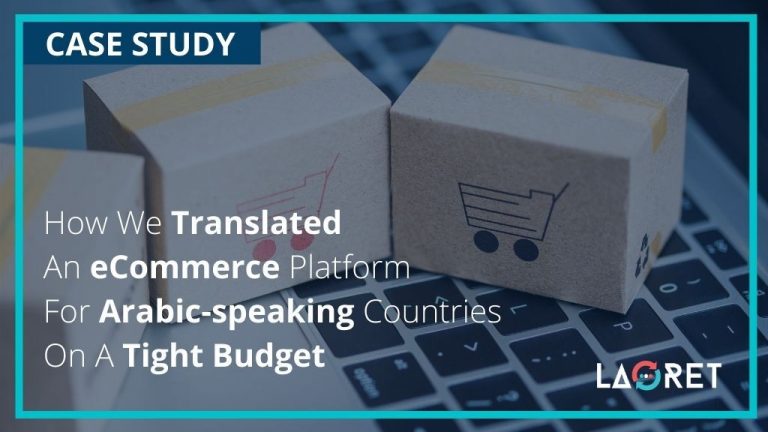How We Translated An eCommerce Platform For Different Arabic-speaking Countries On A Tight Budget

eCommerce Platforms and the Arabic language both have their unique challenges tied to them. So, when a Kuwait-based client with a small budget wanted to expand regionally and localize their Magento eCommerce Platform for the 5 Arab countries within the Gulf Region/Gulf Cooperation Council (GCC), including the eCommerce giants Suadi Arabia, Qatar and United Arab Emirates (UAE), we knew we had our job cut out for us.
The Arabic language is considered a highly complex language to translate to. What’s more, the translation will differ depending on which country in the Gulf region you focus on. The best practice is to produce personalized translation tailored to your target audience/country in addition to the specialized and technical services required for eCommerce content in general. Here are the specific challenges we faced with this project and the solution we offered!
The Challenges
- Translating your content to Modern Standard Arabic (MSA) might be a preferred choice since it is commonly understandable across all Arabic-speaking countries, but alone it is still not enough. The content was mostly marketing-oriented and we needed to produce different Arabic translations adapted to local terminology and preferences.
- There are variations in each country’s terminology. Think of it this way; flat is the preferred terminology in British English, while apartment is commonly used in the US. What does this sound like for Arabic? Watch this Tiktok Video made by two Arabic-speaking ladies. The one on the left is an Egyptian, and the one on the right is from Saudi Arabia. To demonstrate the differences between their dialects, each says the same word according to their dialect.
@hadeelmarei ????? ??? ????? ?? ??????? @amyroko #tiktokarab #makeeverysecondcount #foryourpage ? original sound – Hadeel Marei
- There are some long-term challenges unique to eCommerce Platforms when it comes to the continuous localization of product descriptions and User- Generated Content (UGC).
The translation process can be complex, yet the client wanted it all done within a tight budget. The typical translation process would be to translate the source text directly into each of the regional languages the client requested. however, this would exceed the budget they had provided for this project. Find our solutions below!
The Dream-Team We Put Together
-
Project managers
are selected to organize the process from start to finish, keep up consistent communication with our client, and assign each project to the most qualified professional.
-
Native, in-country linguists
who have years of experience translating for their specific target locale and are also specialized in the eCommerce Industry.
-
Localization engineers
who can quickly fix any technical issues we may encounter and guide the continuous localization process, so it all goes off without a hitch.
The Solutions We Offered
Cost-Effective, Qualitative Translations
So, how did we go about translating an eCommerce platform with a tailored version for each country in the Gulf region? And how did we make it cost-effective? Like we said before, the typical translation process will involve each regional dialect to be translated directly from the source text. However, the usual practices would greatly exceed our client’s budget. So if we couldn’t follow the traditional path, how could we help our client?You may remember that we said MSA is understood within the entire Arab world. So what we did was translate the source text to MSA, and sent this text out to professional editors residing in each of the regions. They applied their linguistic expertise to the content and adapted it to fit the local preferences, dialect, and culture. This way, we were able to provide an accurate translation much faster. And the best part? We were able to reduce the usual price tag by half.
Continuous Translation
But what about the product descriptions and UGC? These won’t benefit from a one-time translation since this type of content keeps popping up. What’s more, an effective translation will need to be both fast and qualitative. Managing Continuous Translation is not as complicated as it used to be. We started by connecting our Translation Management System (TMS) to the client’s platform, in this case Magento, so that we could leverage our Translation (CAT) tools that help increase both productivity and accuracy by implementing partial automation.This way, the translatable content is extracted, and the translation reinserted, without creating any systematic issues.A TMS also includes a Translation Memory (TM), which means that a log is created of frequently used terminology and industry-specific jargon. This way, the same translations are applied to the correct words, and you save a whole lot of money since only the newly translated content gets charged.So, every time our client needs a new translation, the words that were already translated in the past will not be charged again.
Machine Translation Post-Editing
Since product descriptions and UGC have a knack to keep popping up on a regular basis, human translation alone might not be fast enough. This is why, when the strategy demanded it, we offered our Machine Translation Post-Editing (MTPE) Services. MTPE refers to the process of combining the speed of the machine, with the intuition of a human translator through Post-Editing. The Post-Editing Process is still an essential part of the Quality Assurance of your translation, and a valuable tool in promoting global user engagement.Curious to learn more? Check out our blog on eCommerce Localization for the Gulf Region and learn about the current trends, and how other translation challenges can be most effectively solved.

